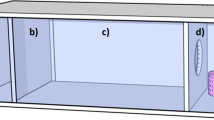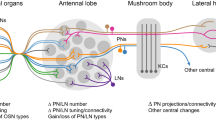Abstract
Ecologically and evolutionarily oriented research on learning has traditionally been carried out on vertebrates and bees. While less sophisticated than those animals, fruit flies (Drosophila) are capable of several forms of learning, and have the advantage of a short generation time, which makes them an ideal system for experimental evolution studies. This review summarizes the insights into evolutionary questions about learning gained in the last decade from evolutionary experiments on Drosophila. These experiments demonstrate that Drosophila has the genetic potential to evolve a substantially improved learning performance in ecologically relevant learning tasks. In at least one set of selected populations, the improved learning generalized to a task other than that used to impose selection, involving a different behavior, different stimuli, and a different sensory channel for the aversive reinforcement. This improvement in learning ability was associated with reductions in other fitness-related traits, such as larval competitive ability and lifespan, pointing to evolutionary trade-offs for improved learning. These trade-offs were confirmed by other evolutionary experiments where a reduction in learning performance was observed as a correlated response to selection for tolerance to larval nutritional stress or for delayed aging. Such trade-offs could be one reason why fruit flies have not fully used up their evolutionary potential for learning. Finally, another evolutionary experiment with Drosophila provided the first direct evidence for the long-standing idea that learning can under some circumstances accelerate and in others slow down genetically based evolutionary change. These results demonstrate the usefulness of fruit flies as a model system to address evolutionary questions about learning.






Similar content being viewed by others
References
Anderson RW (1995) Learning and evolution: a quantitative genetics approach. J Theor Biol 175:89–101
Baldwin JM (1896) A new factor in evolution. Am Nat 30(441–451):536–553
Beecher MD, Brenowitz EA (2005) Functional aspects of song learning in songbirds. Trends Ecol Evol 20:143–149
Bleeker MAK, Smid HM, Steidle JLM, Kruidhof HM, Van Loon JJA, Vet LEM (2006) Differences in memory dynamics between two closely related parasitoid wasp species. Anim Behav 71:1343–1350
Boesch C, Marchesi P, Marchesi N, Fruth B, Joulian F (1994) Is nut cracking in wild chimpanzees a cultural behavior. J Hum Evol 26:325–338
Bolhuis JJ (2005) Function and mechanism in neuroecology: looking for clues. Anim Biol 55:457–490
Borenstein E, Meilijson I, Ruppin E (2006) The effect of phenotypic plasticity on evolution in multipeaked fitness landscapes. J Evol Biol 19:1555–1570
Burger JMS, Kolss M, Pont J, Kawecki TJ (2008) Learning ability and longevity: a symmetrical evolutionary trade-off in Drosophila. Evolution 62:1294–1304
Chittka L, Thomson JD (1997) Sensori-motor learning and its relevance for task specialization in bumble bees. Behav Ecol Sociobiol 41:385–398
Davis RL (2005) Olfactory memory formation in Drosophila: from molecular to systems neuroscience. Annu Rev Neurosci 28:275–302
Dukas R (2004a) Evolutionary biology of animal cognition. Annu Rev Ecol Evol Syst 35:347–374
Dukas R (2004b) Male fruit flies learn to avoid interspecific courtship. Behav Ecol 15:695–698
Dukas R, Bernays EA (2000) Learning improves growth rate in grasshoppers. Proc Natl Acad Sci USA 97:2637–2640
Dyer AG, Rosa MGP, Reser DH (2008) Honeybees can recognise images of complex natural scenes for use as potential landmarks. J Exp Biol 211:1180–1186
Falconer DS, Mackay TFC (1996) Introduction to quantitative genetics, 4th edn. Longman, Harlow
Fontanari JF, Meir R (1990) The effect of learning on the evolution of asexual populations. Complex Syst 4:401–414
Gittleman JL, Harvey PH (1980) Why are distasteful prey not cryptic? Nature 286:149–150
Healy SD, Braithwaite VA (2000) Cognitive ecology: a field of substance? Trends Ecol Evol 15:22–26
Hewitt JK, Fulker DW, Hewitt CA (1983) Genetic architecture of olfactory discriminative avoidance conditioning in Drosophila melanogaster. J Comp Psychol 97:52–58
Hinton GE, Nowlan SJ (1987) How learning can guide evolution. Complex Syst 1:495–502
Ihalainen E, Lindstrom L, Mappes J, Puolakkainen S (2008) Can experienced birds select for Mullerian mimicry? Behav Ecol 19:362–368
Johnston TD (1982) Selective costs and benefits in the evolution of learning. Adv Study Behav 12:65–106
Kamil AC, Jones JE (1997) The seed-storing corvid Clark’s nutcracker learns geometric relationships among landmarks. Nature 390:276–279
Kolss M, Kawecki TJ (2008) Reduced learning ability as a consequence of evolutionary adaptation to nutritional stress in Drosophila melanogaster. Ecol Entomol 33:583–588
Kolss M, Kraaijeveld AR, Mery F, Kawecki TJ (2006) No trade-off between learning ability and parasitoid resistance in Drosophila melanogaster. J Evol Biol 19:1359–1363
Laughlin SB (2001) Energy as a constraint on the coding and processing of sensory information. Curr Opin Neurobiol 11:475–480
Lofdahl KL, Holliday M, Hirsch J (1992) Selection for conditionability in Drosophila melanogaster. J Comp Psychol 106:172–183
Macphail EM, Bolhuis JJ (2001) The evolution of intelligence: adaptive specialization versus general process. Biol Rev 76:341–364
Merkle T, Wehner R (2008) Landmark guidance and vector navigation in outbound desert ants. J Exp Biol 211:3370–3377
Mery F, Kawecki TJ (2002) Experimental evolution of learning ability in fruit flies. Proc Natl Acad Sci USA 99:14274–14279
Mery F, Kawecki TJ (2003) A fitness cost of learning ability in Drosophila melanogaster. Proc R Soc Lond B Biol Sci 270:2465–2469
Mery F, Kawecki TJ (2004) The effect of learning on experimental evolution of resource preference in Drosophila melanogaster. Evolution 58:757–767
Mery F, Pont J, Preat T, Kawecki TJ (2007) Experimental evolution of olfactory memory in Drosophila melanogaster. Physiol Biochem Zool 80:399–405
Nakamichi M, Kato E, Kojima Y, Itoigawa N (1998) Carrying and washing of grass roots by free-ranging Japanese macaques at Katsuyama. Folia Primatol 69:35–40
Odling-Smee LC, Boughman JW, Braithwaite VA (2008) Sympatric species of three spine stickleback differ in their performance in a spatial learning task. Behav Ecol Sociobiol 62:1935–1945
Ohman A, Dimberg U (1978) Facial expressions as conditioned stimuli for electrodermal responses: case of preparedness. J Pers Soc Psychol 36:1251–1258
Ono Y, Hayashi I, Matsushima T (2002) Visual memory of shapes in quail chicks: discrimination among 2-dimensional objects. Zool Sci 19:719–725
Osborn HF (1896) Ontogenic and phylogenic variation. Science 4:786–789
Paenke I, Sendhoff B, Kawecki TJ (2007) Influence of plasticity and learning on evolution under directional selection. Am Nat 170:E47–E58
Papaj DR (1994) Optimizing learning and its effect on evolutionary change in behavior. In: Real LA (ed) Behavioral mechanisms in evolutionary biology. University of Chicago Press, Chicago, pp 133–154
Potter DA, Held DW (1999) Absence of food-aversion learning by a polyphagous scarab, Popillia japonica, following intoxication by geranium, Pelargonium × hortorum. Entomol Exp Appl 91:83–88
Raine NE, Chittka L (2008) The correlation of learning speed and natural foraging success in bumble-bees. Proc R Soc Lond B Biol Sci 275:803–808
Reader SM, Laland KN (2002) Social intelligence, innovation, and enhanced brain size in primates. Proc Natl Acad Sci USA 99:4436–4441
Reif M, Linsenmair KE, Heisenberg M (2002) Evolutionary significance of courtship conditioning in Drosophila melanogaster. Anim Behav 63:143–155
Rescorla RA (1988) Behavioral studies of Pavlovian conditioning. Annu Rev Neurosci 11:329–352
Roff DA, Fairbairn DJ (2007) The evolution of trade-offs: where are we? J Evol Biol 20:433–447
Schlichting CD, Pigliucci M (1998) Phenotypic evolution. A reaction norm perspective. Sinauer, Sunderland
Seppanen JT, Forsman JT (2007) Interspecific social learning: novel preference can be acquired from a competing species. Curr Biol 17:1248–1252
Shettleworth SJ (1999) Cognition, evolution, and behavior. Oxford University Press, Oxford
Stearns SC (1992) The evolution of life histories. Oxford University Press, Oxford
Wittman AB, Wall LL (2007) The evolutionary origins of obstructed labor: bipedalism, encephalization, and the human obstetric dilemma. Obstet Gynecol Surv 62:739–748
Acknowledgments
This work reported here was supported by the Swiss National Science Foundation, the Roche Research Foundation and the Velux Foundation.
Author information
Authors and Affiliations
Corresponding author
Rights and permissions
About this article
Cite this article
Kawecki, T.J. Evolutionary ecology of learning: insights from fruit flies. Popul Ecol 52, 15–25 (2010). https://doi.org/10.1007/s10144-009-0174-0
Received:
Accepted:
Published:
Issue Date:
DOI: https://doi.org/10.1007/s10144-009-0174-0




